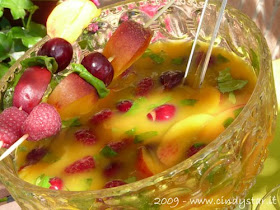
I tedeschi e gli austriaci lo chiamano
Rumtopf, il grande
Pellegrino Artusi la chiamava
frutta in guazzo, di cui ancora ci lascia la ricetta come segue:
"A chi piace le frutta in guazzo, può riuscire gradito il seguente modo di confezionarle. Cominciate dalle prime che appariscono in primavera, cioè: dalle fragole, dal ribes e dai lamponi, e ponetene in un vaso 50 o 100 grammi per sorta; copritele con la metà del loro peso, di zucchero e tanta acquavite o cognac che le sommerga. Poi proseguite con le ciliegie, le susine, le albicocche, le pesche, tutte private del nocciolo e, all'infuori delle ciliegie, tagliatele a fettine, aggiungendo sempre in proporzione zucchero ed acquavite.
Potete mettervi anche uva spina, uva salamanna e qualche pera gentile; ma poi assaggiate il liquido per aggiungere zucchero od acquavite, a tenore del vostro gusto. Formato il vaso, lasciatelo in riposo per qualche mese prima di servirvene".
E' un modo simpatico e per niente difficile per conservare la frutta, zuccherata e macerata nel rum secondo il metodo tedesco, nel bourbon come da tradizione francese, o anche nel brandy o altro preparato liquoroso ad almeno 40% di gradazione alcolica.
Usando il rum l'ideale sarebbe il
Pott 54%, ma qua in Italia è molto difficile da trovare per cui ci si può benissimo arrangiare con un buon rum di qualità e rigorosamente scuro.
Si inizia a primavera inoltrata con le fragole, proseguendo poi durante tutta l'estate aggiungendo i vari tipi di frutta mano a mano che maturano.
Tutta la frutta va pulita, lavata e asciugata, pelata e tagliata a pezzi se necessario, zuccherata e posta nel contenitore apposito. Non occorre comprarne uno originale se non l'avete (io l'ho ricevuto come dono di nozze e allora non sapevo neanche a cosa servisse!), basterà usare un vaso grande di vetro (avvolto con l'alluminio per non far penetrare la luce), sigillato bene con della pellicola trasparente sotto al tappo (quest'accortezza anche usando un contenitore originale) in modo da preservare tutto l'aroma della frutta ed evitare l'evaporazione del rum.
Sul sito di Fantes, dove vendono dei bellissimi contenitori originali, suggeriscono di seguire quest'ordine di frutti:
Fragole: lavate, senza picciolo, a metà le più grandi.
Ciliegie: lavate, senza picciolo, con o senza nocciolo a piacere.
Lamponi e Mirtilli: selezionati accuratamente ma non lavati.
Ribes rosso: lavato bene ed eliminando i piccioli con una forchetta.
Albicocche e Pesche: sbollentate un attimo, pelate e denocciolate, tagliate in quarti (non pelerò le albicocche)
Melone: pelato, senza i semi e tagliato a pezzi.
Prugne: lavate, senza picciolo, tagliate a metà, con o senza buccia e nocciolo a piacere.
Pere: pelate, tagliate in quarti o ottavi.
Uva: lavata bene e senza graspi.
Ananas: sbucciato, senza la parte centrale e tagliato a pezzi.
- Lo zucchero dovrebbe essere sempre la metà del peso della frutta, per esempio su 500 g di frutta si useranno 250 g di zucchero, si lascia macerare la frutta per un'ora poi si trasferisce frutta e zucchero nel vaso.
- Aggiungere il rum a coprire la frutta di almeno un paio di centimetri.
- Ogni volta che si aggiunge nuova frutta, rabboccare col rum.
- Si può aggiungere la frutta ogni mese/settimana/10 giorni, l'importante è che lo zucchero precedente sia sciolto.
- Dopo che è stato aggiunto l'ultimo frutto, metterci un piattino sopra in modo da tenere la frutta ben sommersa nel liquore.
- Tenere il Rumtopf al fresco per 3 mesi per una giusta fermentazione, controllandolo ogni tanto ed aggiungendo ancora rum se necessario.
Ho iniziato la settimana scorsa con le fragole, ora lo zucchero è ben sciolto e in questi giorni aggiungerò le ciliegie (non trovando più quelle belle e buone di Vignola, ho messo le
picota, assaggiate per la prima volta). Ogni volta che inserirò un nuovo frutto, aggiornerò il post con la nuova foto.
Sarà pronto in inverno, giusto per essere gustato durante le feste natalizie su gelati, torte, pandori, panettoni, yogurt, o semplicemente da solo con l'aggiunta di
crema pasticcera,
crema di mascarpone o panna. E' anche una bellissima idea come regalo natalizio, invasato in un bel vaso di vetro con un bel nastro rosso intorno al tappo.

Thanks again to Haalo who manages greatfully all events, Rumtopf, shall we do it together?

"Rumtopf" (meaning rum pot) is a particular fine way to preserve summer fruits soaked in rum and sugar.
The original recipe belongs to Germany and Austria and the best rum to use should be
Pott 54%. Here in Italy it's quite difficult to find but still you can manage with a good quality one at least 40% and defintely not white.
You could also soak the fruit in a good quality bourbon, in the French tradition, or in your favorite brandy or other alcoholic beverage that is at least 40% alcohol by volume.
You start in late spring, the best time to find strawberries at their best, the first fruit to start with. And you will keep going on all summer long, choosing fruits as soon as they ripe and become seasonally available.
All fruits should be washed, dried, peeled and cut in pieces if necessary, sugared and put in the Rumtopf crock. Don't bother to buy a new one, (I had mine as a wedding present and at that time I didn't even know what was it for!) you can use a large glass jar wrapped with aluminium foil (to avoid light that might pale fruits) and sealed with transparent plastic film on top under the lid to avoid loss af aroma or evaporation of rum (to do with a Rumtopf crock as well).
On
Fantes' site, where you can buy beautiful Rumtopf crocks, they suggest to follow the order below:
Strawberries: Wash, remove the stems and halve large ones.
Cherries: Wash, remove stems, and use with or without the pits.
Raspberries and/or Blackberries: Sort carefully, but do not wash.
Red Currant Berries: Wash well and remove from stem with a fork.
Apricots and/or Peaches: Scald for 1 or 2 minutes, peel and pit, and cut in quarters (I won't peel apricots).
Melons: Peel, remove seeds and cut in cubes.
Plums: Wash well, remove stems, cut in half, and use with or without skin or pits.
Pears: Peel, cut in 4 or 8 slices, simmer in mixture of sugar and water, then remove from mixture.
Grapes: Wash well and remove from stem.
Pineapples: Remove the rind and center core, and cut in cubes.
- Sugar should always be half weight of fruit, so on each 500 g of fruit, evenly sprinkle 250 g of fine sugar, let soak for at least one hour, then place in the jar.
- Cover the fruit with rum, about 1" above the fruit.
- As you add the next fruit, keep topping off with rum.
- You can add fruit every month/week/10 days, it's sufficient that previous sugar has totally melted.
- After the last fruit has been added, place a dish over it to keep the fruit fully immersed in the rum.
- Keep the Rumtopf in a cool place for three months for a proper fermentation, chek it occasionally adding more rum if necessary.
I started last week with strawberries, now sugar is all melted and I will add cherries in the next days, trying a new variety I never tasted before:
picota. I will update pictures as soon as a new fruit is in the jar.
Rumtopf will be ready in winter, just to be enjoyed at Christmas time over ice cream, cakes, yogurt, or simply by itself with a topping of cream. It's also a nice idea for Christmas gifts, stored in small glass jars with a shining crimson ribbon around the lid.
Round up WHB # 189































